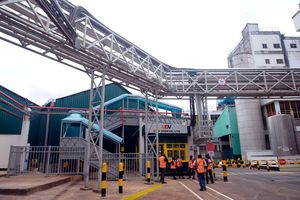Women, children take the brunt of floods in El Nino-ravaged counties
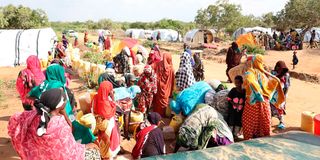
Women fetch water trucked to their camp at Danisa on December 21, 2023. CSW has adopted a blueprint that seeks to end extreme poverty among women.
What you need to know:
- Many households have had to move to camps after they were displaced by floodwaters.
- They grapple with hunger, waterborne diseases, and a disrupted healthcare system.
It is a bright morning as we make our way to Garissa town about 370 kilometres from Nairobi. The weather is unforgiving; it’s blazing hot.
We are here on a mission: to assess the impact of the El-Nino floods particularly on women and girls.
Garissa is among eight counties most affected by the El-Nino floods that hit the country in November and December last year.
We make our way to an internally displaced people (IDP) camp at the Young Muslim Secondary School grounds.
It is home to more than 400 households. The compound is dotted with makeshift shanties that spread as far as the eyes can see.
Here, we meet Mariam Isaak, a mother of four. When we strike a conversation, she recalls the events of one fateful Sunday night, in November last year, that drastically changed her life.
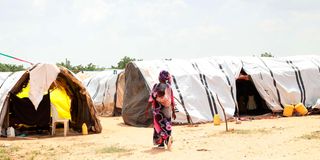
A woman walks at Young Muslim High School IDP camp in Garissa on December 19, 2023.
She was deep asleep at around 1am, when her bed was suddenly filled with water. Alarmed, the lactating mother jumped out of bed with her four-month-old baby and dashed to the other bedroom to help her three children swim through the raging waters.
“We were lucky to get out of the heavily flooded house alive. Our house and everything therein were swept moments later. We watched helplessly, we could not salvage anything,” Mariam tells Nation.Africa.
To make ends meet, Mariam works as a cleaner in a nearby private hospital. She terms her salary of Sh3,000 a month a drop in the ocean for her family of five, in the wake of tough economic times.
Hardship
The single mother lists issues that are pressing for people living in the camp.
“Lack of water is affecting our hygiene. Poor sanitation has also resulted in waterborne diseases like cholera. We also lack food and this is taking its toll on us, especially pregnant and lactating women,” Mariam says.
A few metres away, we meet Fatuma Abdillahi. She is pregnant with her third child. This is her second month in the camp, she says.
It is about 2pm and she looks weak. When we start off our conversation, Fatuma says she has not eaten since morning.
“I have nothing to cook. My children, too, have not eaten anything today. If my husband fails to come back to the camp with something, we will sleep hungry. This worries me as it could affect the well-being of my unborn baby,” says the mother of two.
Her husband, she says, is a charcoal dealer. The business has been affected by the floods, with parcels of land where they burn the charcoal remaining submerged.
Lack of health services in the camp also worries Fatuma. She is unable to attend antenatal clinics on a regular basis as required for expectant mothers.
She, however, visits the nearest public hospital, about 10 kilometres away once in a while. She walks to the hospital because she can’t afford transport. She covers the journey of 20 kilometres to and fro, on an empty stomach, in most cases.
The elderly at the camp are also not spared. For 90-year-old Hawa Nalaga, life here is tough. Her daughter, Habiba Bamalo, says they struggle to put food on the table.
“My mother is sick, I have no money to take her to hospital and buy her food. She survives on porridge. We also urgently need medical services. People here are suffering,” Habiba tells Nation.Africa.
These women’s tales mirror those of thousands of others in IDP camps across Garissa County.
Two months since they moved to the camp, the people here say they have only received food aid from the government once.
Data from the county government shows there are currently 19 IDP camps hosting 7,278 households.
Garissa Township leads with 4,114 households, with the remaining 3,164 coming from the other sub-counties.
By the time of doing this story, eight people had lost their lives to the floods. Major roads connecting the sub-counties were also extensively damaged, with 58 boreholes totally submerged.
Aden Hussein Ibrahim, the director health service in Garissa County, says 68 health facilities are not accessible while15 have been submerged across the six sub-counties.
He adds that more than 312 medical outreach sites are not accessible, affecting immunisation of babies and children’s access to nutritional commodities.
“The county is paralysed, unable to provide health services. Drugs in the affected health facilities were washed away, while buildings and equipment were destroyed.
"Out of the 15 health facilities submerged, five have yet to be restored back,” Mr Ibrahim says.
The county official acknowledges that women, girls and children are the most affected by the disruption of health services.
Among the critical services disrupted are antenatal and postnatal clinics, immunisation of babies, deliveries, reproductive health services like family planning and general medical services.
“We are, however, trying through partnerships, to ensure we provide essential medical services. We are putting up mobile clinics in the camps to help expectant mothers and immunisation of babies,” he says.
Mohammed Dubow, the director of special programmes, coordination and partnerships, says the county, together with partners, carry out medical outreaches that offer psychosocial and mental health services.
He says waterborne diseases are on the rise following the floods, and that they need many mosquito nets, especially for expectant mothers and children.
The floods have also affected access to basic reproductive health services and needs among teenage girls and women of reproductive age, including availability of sanitary towels and family planning services.
Open defaecation—which has led to waterborne diseases, including cholera and diarrhoea—has become commonplace because there are not enough latrines.
On the day of our visit, however, the women and girls have something to smile about.
The United Nations Population Fund (UNFPA) is here to donate reproductive health supplies, including 826 Mama Kits, sanitary pads, girls’ and boys’ dignity kits, girls’ and boys’ underwear, and inter-agency reproductive health kits.
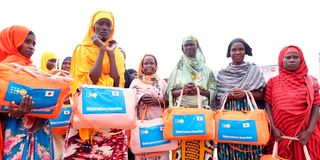
Women get essential supplies from UNFPA and Kenya Red Cross at Young Muslim High School camp in Garissa on December 19, 2023.
Mama Kit consists of basic supplies required at childbirth that include sterile gloves, plastic sheets, cord ligature, razor blades, tetracycline, cotton, soap and sanitary pads.
They are designed to provide contraceptives, treat sexually transmitted diseases, ensure a clean and safe delivery or to manage the consequences of rape.
John Wafula, the humanitarian vocal point at UNFPA Kenya, is leading a team to assess the impact of the El-Nino floods on women and girls' health.
Worrying trend
He terms it is worrying when pregnant women and lactating mothers, displaced by the floods, are unable to access vital health services.
“There is a need for robust advocacy to put reproductive health as a key response to El-Nino. It is important that counties upscale their allocations to reproductive health,” Mr Wafula tells Nation.Africa.
Rukia Hamisi, a beneficiary of the reproductive health supplies, is elated.
“The sanitary towels I have received will push me to the next month. I will not need to borrow from friends,” she says,
The county executive member in charge of Culture, Gender, Youth and Sports, Hawa Abdi, singles out lack of water and poor sanitation as among the major problems those in the camps grapple with.
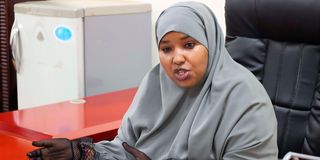
Garissa County Gender CEC Hawa Abdi Sahal during an interview on December 18, 2023.
“There is so much suffering in the camp, especially among women, girls and children,” Ms Abdi notes.
Kenya Red Cross Garissa County acting Coordinator Daud Ahmed acknowledges that the situation is dire, posing a risk to pregnant women and lactating mothers.
He reveals that there are currently 300 pregnant women and lactating mothers in IDP camps across the county.
“Kenya Red Cross and partners are distributing food and non-food stuff to people in IDP camps.
"We are also carrying out medical and nutritional outreaches, and making referrals for serious medical and malnutrition cases to hospitals,” Mr Ahmed says.
They are also supporting 400 households with a Sh12,000 monthly stipends for two months, courtesy of support from the European Union (EU) and the Norwegian Red Cross.
More than 100 kilometres away in Hatata IDP camp in Tana River County, we meet Rebecca Kanugu. She is seated on an old timber stool and looks emaciated.
The mother of five is struggling to wash some clothes. Besides her is a small shanty made of worn-out plastic bags. Inside it is a worn-out mattress and blanket.
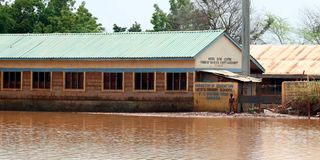
A flooded Hatata Primary School field in Tana River County on December 18, 2023.
“That’s my house,” Ms Kanugu says as she hands a plastic chair to this writer.
She finally opens up and narrates how she survived death by a whisker when flooding struck one night in November last year.
Even though she survived, she contracted pneumonia and some strange skin disease after coming into contact with and consuming contaminated floodwater.
“I have been diagnosed with pneumonia but have no money to buy the prescribed drugs. In my condition, I can’t work; I depend on well-wishers for food,” Rebecca says.
She lost everything to the floods, something that worries her a lot.
“My mud-walled house together with all my household items were swept by the floods. I need to rebuild my life afresh, but I do not know where to start from,” she says.
At Peponi IDP camp in Garsen Constituency, 15-year-old Hawa Mohammed* is sleeping outside their makeshift shanty.
The girl, who stays with her grandmother in the camp, is unwell. Her greatest problem, she says, is lack of food, water and sanitation characterised by lack of toilets.
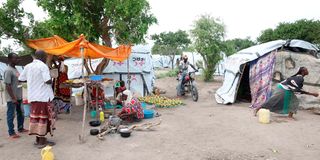
Peponi IDP camp in Garsen, Tana River County, on December 22, 2023.
“Getting sanitary towels has also been a big problem. My grandmother can’t afford to buy it for me. Last month, I borrowed from friends. This month, they did not have any to share and I had to use pieces of cloth,” she says.
Scores of women and girls in different IDP camps share similar tales. Tana-Delta has been the most-affected region in the county after the Tana River broke its banks.
According to Tana-Delta Assistant County Commissioner Peter Ndambo, the situation in the camps is worrying. They urgently need food and water.
“We have cases of cholera in some camps because the water people take is not safe. It needs chemicals to purify it,” he says.
Reproductive health challenges
Tana River County gender-based violence (GBV) campaign coordinator Hawa Abdul says women and girls in the camps suffer more than men do.
She observes that lack of access to sexual and reproductive health commodities is their undoing.
Ms Abdul is apprehensive that cases of teenage pregnancy could arise as adolescent girls continue to be exposed to insecurity in the camps.
UNFPA donated reproductive health supplies consisting of Mama-kits, sanitary pads, girls’ and boys’ dignity kits and underwear, and Inter-Agency Reproductive Health kits in Tana River too.
Tana River Governor Dhadho Godhana says the county needs Sh2 billion to deal with the effects of El Nino.
He explains that currently, 171,168 people and over 28,000 households have been affected since the start of the rains. They live in 53 IDP camps.
Six people in the county have died, with one death attributed to cholera outbreak. The floods have also destroyed 11 health facilities.
National toll
The El Nino floods have claimed 174 lives countrywide. The National El Nino Emergency and Disaster Response Command Centre in a recent statement said the floods claimed 133 adults and 41 children.
“The agricultural sector has also been severely impacted, with crop devastation affecting around 84,568 acres,” the statement read.
The government has estimated that the damage to the agricultural sector amounts to Sh16.26 billion. Counties worst hit by El-Nino include Lamu, Tana River, Garissa, Mandera, Wajir, Homa Bay, and Kitui, posing a threat to food security.
The rains have caused havoc in more than 19 counties in the arid and semi-arid lands (Asal) and non-Asal areas. The counties include Mombasa, Garissa, Tana River, Makueni, Marsabit, Kilifi, Kwale, Meru, Isiolo, Turkana, Samburu, Wajir, Homa Bay and Busia.
*Name changed to protect the identity of the teenager.





